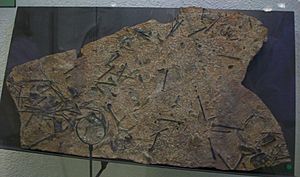Presbyornis facts for kids
Presbyornis was an ancient water bird that is now extinct. It looked a bit like a duck but had very long legs and a long neck, similar to a flamingo. This bird lived a long, long time ago, during the Paleocene and Eocene periods.
Quick facts for kids Presbyornis |
|
|---|---|
 |
|
| Skeletons of Presbyornis pervetus at the American Museum of Natural History | |
| Scientific classification |
|
| Kingdom: | Animalia |
| Phylum: | Chordata |
| Class: | Aves |
| Order: | Anseriformes |
| Family: | †Presbyornithidae |
| Genus: | †Presbyornis Alexander Wetmore, 1926 |
| Species | |
|
|
Contents
Meet Presbyornis: The Duck-Flamingo Bird
Presbyornis was a very interesting bird. When its fossils were first found, scientists thought it was a type of flamingo because of its long legs and neck. But later, they looked closely at its skull and bill. They found that these parts looked much more like a duck's! This showed that Presbyornis was actually an early relative of modern ducks and geese.
How Presbyornis Found Food
This ancient bird had a wide, flat bill. It used this bill to filter its food from the water. Just like today's dabbling ducks, Presbyornis would probably have sifted through shallow water. It would have eaten tiny plants and small animals found in the water.
Where Did Presbyornis Live?
Scientists have found many complete skeletons of Presbyornis. A lot of these fossils come from places like the Green River Formation in the United States. This area is famous for its early Eocene fossils.
Living in Colonies
Finding so many skeletons together suggests that Presbyornis probably lived in large groups. They might have nested in colonies, just like many waterfowl or shorebirds do today. This means they would have built their nests close to each other, perhaps for safety.
Fossil Discoveries Around the World
Fossils of Presbyornis have been found in several different places. Besides the Green River Formation, they have been discovered in Maryland and Utah in the United States. Scientists have also found them in England and Mongolia. This shows that these birds lived in many parts of the world a long time ago.
Where to See Presbyornis Fossils
You can see fossils of Presbyornis in several museums. Some are kept at the Smithsonian Institution in the U.S. Others are at the Natural History Museum in London, England. The University of Kansas Natural History Museum also has some of these ancient bird fossils.
See also
 In Spanish: Presbyornis para niños
In Spanish: Presbyornis para niños


